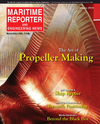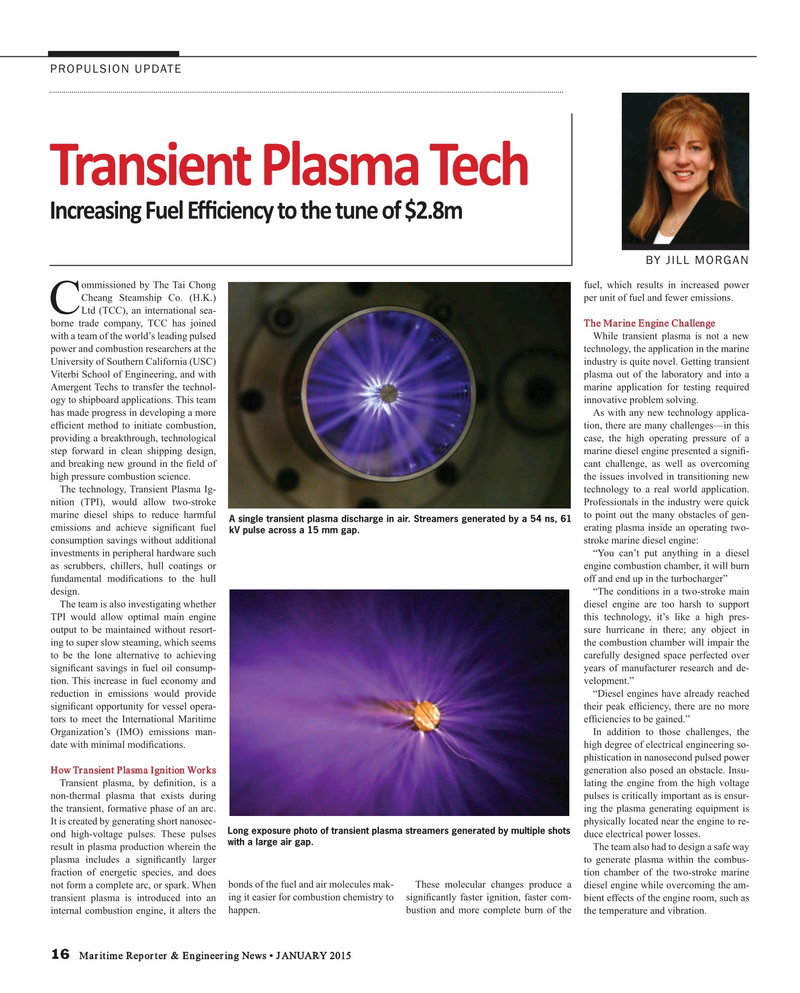
Page 16: of Maritime Reporter Magazine (January 2015)
Ship Repair & Conversion Edition
Read this page in Pdf, Flash or Html5 edition of January 2015 Maritime Reporter Magazine
PROPULSION UPDATE
Transient Plasma Tech
Increasing Fuel E? ciency to the tune of $2.8m
BY JILL MORGAN ommissioned by The Tai Chong fuel, which results in increased power
Cheang Steamship Co. (H.K.) per unit of fuel and fewer emissions.
CLtd (TCC), an international sea- borne trade company, TCC has joined The Marine Engine Challenge with a team of the world’s leading pulsed While transient plasma is not a new power and combustion researchers at the technology, the application in the marine
University of Southern California (USC) industry is quite novel. Getting transient
Viterbi School of Engineering, and with plasma out of the laboratory and into a
Amergent Techs to transfer the technol- marine application for testing required ogy to shipboard applications. This team innovative problem solving. has made progress in developing a more As with any new technology applica- ef? cient method to initiate combustion, tion, there are many challenges––in this providing a breakthrough, technological case, the high operating pressure of a step forward in clean shipping design, marine diesel engine presented a signi? - and breaking new ground in the ? eld of cant challenge, as well as overcoming high pressure combustion science. the issues involved in transitioning new
The technology, Transient Plasma Ig- technology to a real world application. nition (TPI), would allow two-stroke Professionals in the industry were quick marine diesel ships to reduce harmful to point out the many obstacles of gen-
A single transient plasma discharge in air. Streamers generated by a 54 ns, 61 emissions and achieve signi? cant fuel erating plasma inside an operating two- kV pulse across a 15 mm gap.
consumption savings without additional stroke marine diesel engine: investments in peripheral hardware such “You can’t put anything in a diesel as scrubbers, chillers, hull coatings or engine combustion chamber, it will burn fundamental modi? cations to the hull off and end up in the turbocharger” design. “The conditions in a two-stroke main
The team is also investigating whether diesel engine are too harsh to support
TPI would allow optimal main engine this technology, it’s like a high pres- output to be maintained without resort- sure hurricane in there; any object in ing to super slow steaming, which seems the combustion chamber will impair the to be the lone alternative to achieving carefully designed space perfected over signi? cant savings in fuel oil consump- years of manufacturer research and de- tion. This increase in fuel economy and velopment.” reduction in emissions would provide “Diesel engines have already reached signi? cant opportunity for vessel opera- their peak ef? ciency, there are no more tors to meet the International Maritime ef? ciencies to be gained.”
Organization’s (IMO) emissions man- In addition to those challenges, the date with minimal modi? cations. high degree of electrical engineering so- phistication in nanosecond pulsed power
How Transient Plasma Ignition Works generation also posed an obstacle. Insu-
Transient plasma, by de? nition, is a lating the engine from the high voltage non-thermal plasma that exists during pulses is critically important as is ensur- the transient, formative phase of an arc. ing the plasma generating equipment is
It is created by generating short nanosec- physically located near the engine to re-
Long exposure photo of transient plasma streamers generated by multiple shots ond high-voltage pulses. These pulses duce electrical power losses. with a large air gap.
result in plasma production wherein the The team also had to design a safe way plasma includes a signi? cantly larger to generate plasma within the combus- fraction of energetic species, and does tion chamber of the two-stroke marine not form a complete arc, or spark. When bonds of the fuel and air molecules mak- These molecular changes produce a diesel engine while overcoming the am- transient plasma is introduced into an ing it easier for combustion chemistry to signi? cantly faster ignition, faster com- bient effects of the engine room, such as internal combustion engine, it alters the happen. bustion and more complete burn of the the temperature and vibration.
16 Maritime Reporter & Engineering News • JANUARY 2015
MR #1 (10-17).indd 16 MR #1 (10-17).indd 16 1/7/2015 9:47:03 AM1/7/2015 9:47:03 AM

 15
15

 17
17
